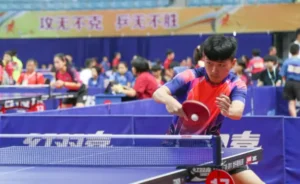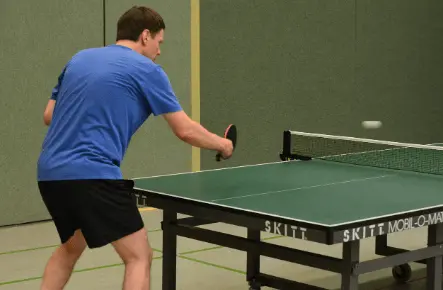A Ping pong specification table also commonly known as Tennis Table Specifications. It is an indoor sport where two or four players played between them on a hard table, the Table Tennis Table separated by a TT Net. The game requires players to hit a hollow light ball, known as a TT ball, back and forth using a small round bat. Which is also termed as TT racket, The Equipment used in this game that is all manufactured as per the international standard released by International Table Tennis Federation.
A ping-pong table is a flat, rectangle portion (body) used for playing table tennis. People of all Altered Ages adore the sport as an amusement and akin to play competitively. Tennis table must fulfill some measurements to provide everyone a nice game.
In this post, we take a look at main table tennis table features in accordance with the International Table Tennis Federation and share some basic information for purchasing your own personal table.
Primary Tennis Table Specifications
Dimensions:
Length: 274 cm (108 in)
Width: 152.5 cm (60 in)
Height: 76 cm (30 in)
The entire suite of dimensions is standardized so that all competitive and recreation tables have the exact same layout.
Surface:
Primary Tennis Table Specifications are important and also its surface as it converts the table to be smooth and non-porous for the best ball bounce and control.
Typical Materials: wood, composites, glass
Color: The surface should be of dark color, usually blue or green, to make the white ball more visible.
Net:
- Height: 6 in (15.25 cm) above playing surface
Width: 183 cm (72 in).
Substance: The substance of the net should be mesh type so that the ball goes through it smoothly. - Legs:
Height: 76 cm
Vibration dampening: The legs are required to be strong and sound in order to avoid the table wobbling when you hit the ball.
Foldability:
Many table tennis tables fold up for easy storage and transport. She speculates that the table is collapsible, but if it is indeed fold-able there better be some kind of lock on it, otherwise that thing will just fall over all during play.
Table Surface Specifications
The so-called “playing surface” (table-top) is a determining factor during a game, dictating how the ball will behave. But what does it mean in practice?

Material and Color
An even bounce is required across the entire spread of the table, so chose the playing surface wisely. These are typically made from high-density fiberboard or plywood.
A typical table is dark green or blue, and its edges are made of wood that has a matte finish to ensure there is no glare from the overhead lighting for players.
Bounce Quality
The bounce is one of the most significant characteristics that are needed to be taken care when it comes to Table Tennis Tables.
Primary Tennis Table Specifications consist The ITTF mandates that a regulation table tennis ball must return a height of 23 cm (9 in) when dropped onto a standard steel block from the width of 30 cm (12 in).
This kind of bounce consistency is game changing for competitive integrity, as it means players can predict where the ball will be rather easily.
Two centimeter wide white lines edge the table, outlining the outlines of a 274 cm by 152.5 cm playing surface. There is also a long centerline, 3 mm thick, that runs parallel to the table. It is especially crucial for doubles play due to the way it teaches players to split when serving.
The Net Assembly
However, the net and how it is set up are often neglected, even though both play an important role in a fair game.
The net should
- Lying flat across the table
- Have a side securely attached to post assembly
- Protruding 15.25 cm (6 inches) above table surface and along axis for the length of the table.
- There must be 6 inches (15.25 cm) of overhang beyond the surface edges of the table to make sure it covers all spaces.
- Before setting up the table, be sure to fix the net with the required height and tension, since it is not allowed for the middle part to sag. A high quality of net assembly assures that the ball performs unified when impacted.
Table Thickness
The size of the table-top can be one of the main variables that impact how well a ping pong table will play. A majority of all tables used in online play have a 22 mm or 25 mm surface thickness.
25 mm.
The top thickness of a professional table, offering the highest-quality and standards bounce.
22 mm (0.87 inches).
High-quality tables, though somewhat thinner than what the professional play would entail. These are the most commonly seen type of style in clubs or amateur tournaments.
Recreational and more cost-effective cheap tables often have as thin a surface as 12 mm. While these might do the job for family fun, they simply lack the bounce consistency present in thicker, competition-standard tables.
Undercarriage and Frame
Primary Tennis Table Specifications consist A strong undercarriage/frame is vital for the table’s longevity & performance. The table needs to be constructed from a high-grade steel or lightweight aluminum frame that will certainly not shake during play.
Key Features to Look For in the Undercarriage:
On The Undercarriage: Features to Keep An Eye Out For
- Folding Mechanism: most recent tables have a folding mechanism to make it easier storage. Good locking mechanisms should keep the table in place when unfolded.
- Wheel System: As we mentioned before, if you need to move the table a lot when playing in different rooms. Make sure you buy a table with a large wheel system and that can be locked so that they do not spin on their own.
- Some tables have legs that can be adjusted to stabilize the surface on an uneven ground.
- However, it is also played in parks and public spaces more generally as a casual form of play. On that note, a table sitting out in the elements must be sturdy and constructed of materials designed to hold up under varying open-air conditions.
Indoor VS Outdoor Tables
Indoor Tables : These are usually in wood or fiberboard should only use in climatically controlled conditions, so that it doesn’t warp from the humidity.
Outdoor Tables : Manufacturers make outdoor dining tables from weatherproof materials, such as aluminum composite, to ensure they remain strong in varying climates. They often coat these tables to protect them from rain, sun, and other elements.
Factors to Consider When Buying a Tennis Table
Important Points to think about while buying a Table Tennis Table
Competition or Recreational: Is the table an investment for leisurely gameplay, or have you developed a serious competitive streak?
Available Space: Is there enough room for a regular sized table?
Cost: How much are you willing to spend on a tennis table?
Portability: Do you desire a table that easy to carry and store?
Durability: This may be quite clear, but a good table is not only made of higher-quality items; it is also decently built.
Additional Features
Such as In them, many additional features are provided by table tennis makers in last few years to make the product more users friendly like:
Here are Playback Mode types of tables use camera-tables-cleaning tab how to cover their ground, so one side folds up for solo practice. This is especially handy if you are looking to hone your craft without having a partner.
Corner Ultralight Cushion: By eliminating the corners, we have reduced any chance of injury when running around the table.
Storage Compartments: Several tables offer a number of in mold storage compartments for the balls also paddles, allowing you to have everything neat and easily accessible.
Find the Best Table for Your Space
WHAT KIND OF TABLE TENNIS TABLES TO LEARN IF YOU ARE A PROFESSIONAL OR HOBBY INTERESTED IN AT HOME PLAY:
Professional Tables: For tournament play or for serious practice of table sports such as tennis, you should consider choosing a high-quality table that accords with ITTF specifications. They will need to be at least 25 mm thick, made of strong build fabrics, and have a well-made net setup.
Recreational use: If you’re just going to be playing for fun against family and friend, a 19-22 mm table can still provide you with a great opportunity at an attractive cost. When space is a concern, look for portability features such as wheels and folders.
During Outdoor Use: Table must be weather-resistant and outdoor facing, if you want to let it outdoors round the year.
Conclusion:
The table tennis Table selection is more complicated than presented; it’s not just any flat surface to hit a ball over. In order for you to fully experience what the game brings and enhance your skill as well, it is important that you also have a table designed appropriately for foosball. Knowing the primary tennis table specifications can help you make an effective decision. Whether you want to play competitively or just for fun From bounces, materials to favorite features such as how well it folds for storage. This will help you build the best trampoline brand profile will help you pick the perfect table for your needs.
If you are eager to know more About us then click
Difference Table of the Article
| Feature | Specifications | Description |
|---|---|---|
| Dimensions | Length: 274 cm (108 in) Width: 152.5 cm (60 in) Height: 76 cm (30 in) |
Standard dimensions for all competitive and recreational tables. Ensures uniformity in size. |
| Surface Material | Wood, Composites, Glass | The material must be smooth and non-porous for optimal bounce and control. |
| Surface Color | Blue or Green | Dark colors make the white ping pong ball more visible during play. |
| Net | Height: 6 in (15.25 cm) Width: 183 cm (72 in) Material: Mesh type |
The net should lie flat, be securely attached, and extend beyond the edges of the table (15.25 cm). |
| Legs | Height: 76 cm | Legs must be sturdy and vibration-dampening to prevent wobbling during intense play. |
| Foldability | Yes (if applicable) | Many tables fold for easy storage and transport. A locking mechanism is required to prevent collapse. |
| Bounce Quality | ITTF Specifications: Bounce height of 23 cm (9 in) when dropped from 30 cm | Ensures consistent and predictable ball bounce for fair play in both competitive and recreational settings. |
| Table Thickness | 12 mm (Recreational) 22 mm or 25 mm (Professional) |
Thickness affects bounce quality. Professional tables have thicker surfaces for higher-quality play. |
| Undercarriage/Frame | High-grade steel or lightweight aluminum frame | Strong frame ensures stability and longevity, preventing shaking during play. |
| Folding Mechanism | Yes (on most models) | Facilitates easy storage. A good lock system keeps the table in place during play. |
| Wheel System | Yes (optional) | Large, lockable wheels are recommended for easy transport and storage. |
| Indoor vs. Outdoor | Indoor (wood/fiberboard) Outdoor (weather-resistant materials like aluminum composite) |
Indoor tables are for controlled environments; outdoor tables are made to withstand the elements. |





